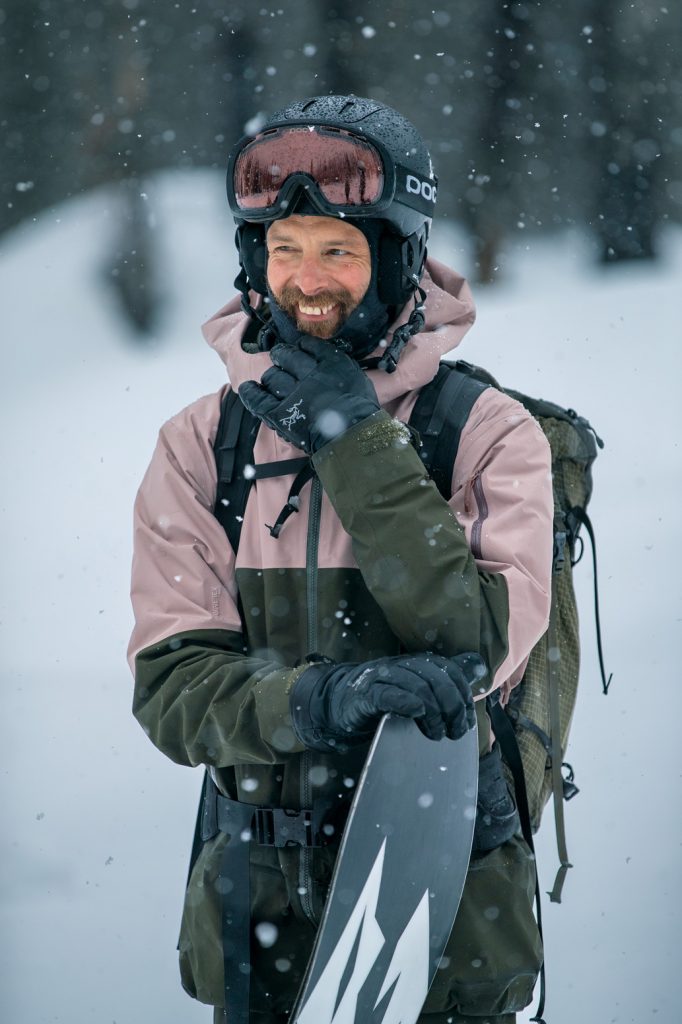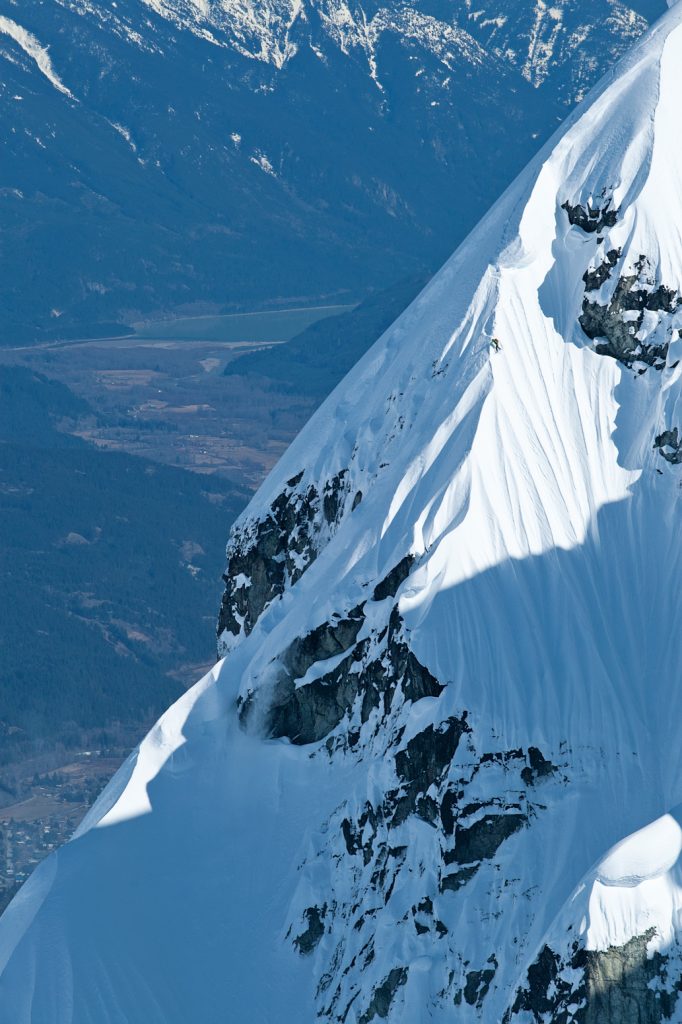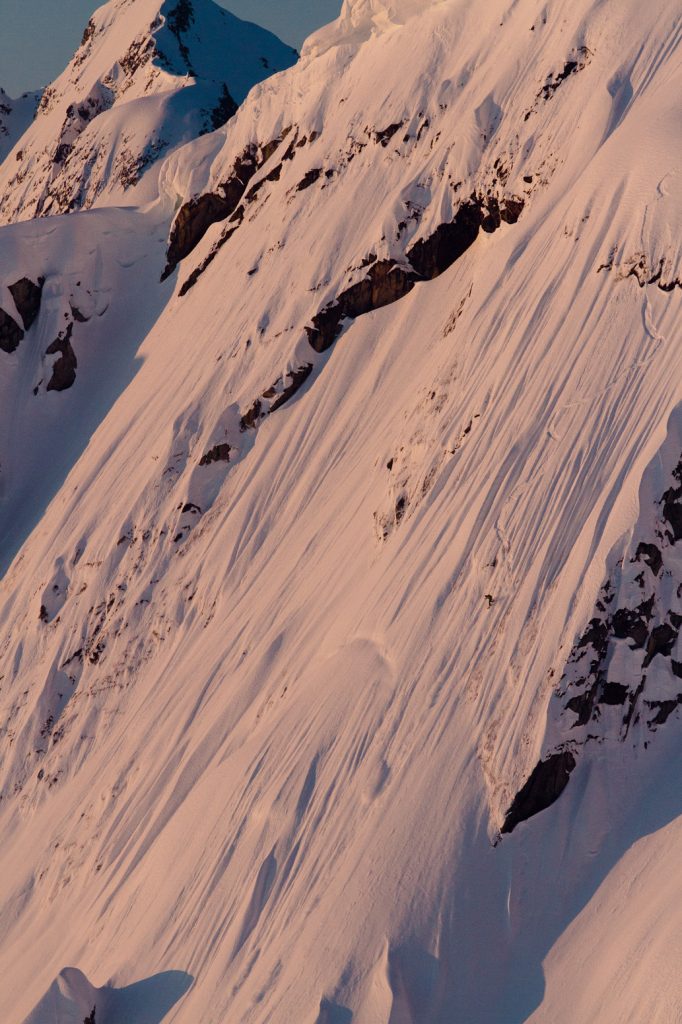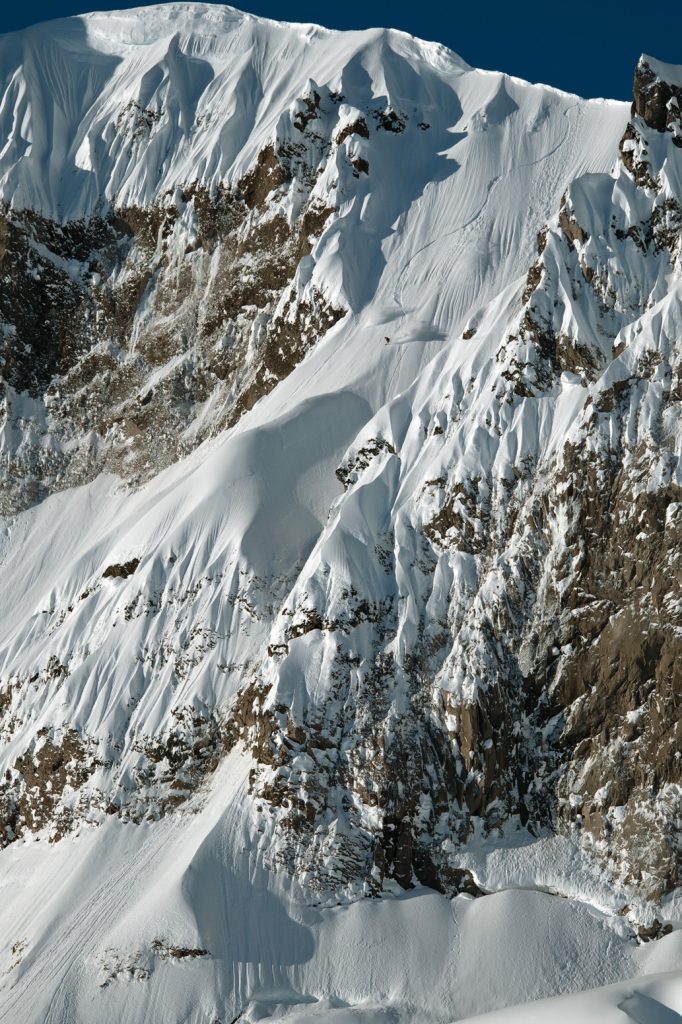Profile
Joe Lax
Chasing Something: Joe Lax Finds His Line
First published in Volume 21, Issue 1 of The Snowboarder’s Journal
This feature story is supported by Arc’teryx
It’s 7:04 a.m. and Joe Lax is atop Dragonslayer, a steep, terminally exposed line in British Columbia’s Coast Mountains. The surrounding peaks are glowing. In a moment, they will shine red, briefly holding the last purple hues of dawn before gold pushes through. Joe will be on slope, navigating the crux of his line above hundreds of feet of raw, exposed rock. He’ll carry speed through his last critical moves, then open things up as the alpenglow peaks. As his sluff echoes through the cirque, he’ll stop on an island of safety, regrouping and processing adrenaline on the glacier. He’ll call on the radio, pass along beta and focus on his partner’s drop.
Dragonslayer is one of many premier lines Joe pioneered near his home in Pemberton, BC. Like many of Joe’s spots, it’s on the magnitude of Mavericks. Joe specializes in burly, technical terrain, at home in the most consequential corners of the Sea to Sky Highway. His open-throttle confidence shows mastery born of dedicated practice, of deep understanding of the mountains and their idiosyncrasies. Joe operates at a similar level in his professional life, working with one of the BC Wildfire Service’s elite incident management teams as an operations section chief. Yet he’s unassuming, embodying more the demeanor of a sardonic punk rather than the bravado you’d expect from the best rider in the range, or a firefighter making calls when towns are threatened. For Joe, stature is corollary. Even now, at the height of his game and with significant media budget behind him, Joe stays unflinchingly grounded, satisfied by the DIY ethos that brought him to his current level.
A storm boarding trip to Mica Heliskiing, BC, with Arc’Teryx—Joe soaking up a rare luxury experience. Photo: Angela Percival
It started on a farm in Lumsden, SK. Joe was an athletic kid, into baseball and wrestling, up for a game of hockey on the backyard pond. “It wasn’t really a hub for snowboarding,” he says, stating the obvious with a laugh. “It wasn’t on my radar, not as a kid anyways.” We’re sitting at his kitchen table; his youngest daughter Thora is eating breakfast at the counter. Neither she nor her sister Freja will be able to say the same about their upbringing with regard to snowboarding—at ages 7 and 12, they already rip. “As soon as I saw there were more individual sports, things that weren’t tied to a team, that resonated,” Joe says. “I got a dirt bike around 12 or 13, got a mountain bike, that kind of stuff.”
Independence was part of the rural package, along with an older brother and younger sister who were Joe’s friends by necessity. “I was outside of town, so I was kind of forced to hang out by myself, or with my siblings,” he says.
He managed all right, putting in work at the farm. There were little thrills like jumping on a cow’s back and holding on as it bucked, but by and large Joe was a helping hand in a happy family. Still he had a critical edge—by adolescence, he was ready to embrace new perspectives. “Punk [music] was definitely an early influence,” he says. “All exposure to music up to that point was on the radio or your parents’ vinyl. Some of it was good and some of it wasn’t. But punk was so different; I don’t think it would have made sense to anyone from a previous generation. Somehow, we managed to acquire SNFU’s …And No One Else Wanted to Play and that opened the door to bands like Dead Kennedys and Propagandhi. That music offered a different take on society, sometimes in a funny or sarcastic way, but sometimes more pointed and political. It pointed out some realities, and it kind of opened my eyes like, ‘OK, the world isn’t quite how it’s presented.’”
“NO THOUGHTS OF GOING HOME, NO PRESSURE, JUST FOCUSED ON SNOWBOARDING EVERY DAY.”
Up before dawn for first light-lines, Joe saw this one catching light in the afternoon. He’d never ridden this variation before and conditions led him into what he calls “a blind roll, edge-of-the-Earth line,” alongside Dave Basterrechea and Delaney Zayac. Photo: Bradley Slack
Fresh out of high school in 1996, Joe moved to Lake Louise, AB. “I knew I wanted to get the hell out of Saskatchewan,” he says. “I had no idea what I wanted to be or what I wanted to do. I didn’t want to go to university and become an engineer to work at the oil refinery like the rest of my friends. I just knew I needed to get out of Dodge.” His brother had made the move a year earlier, and Joe was taken by the vibrant scene when he visited. “We got some fake IDs printed and went to see what it was all about, and it was pretty clear between the snowboarding, the partying and the music that there was something going on there,” he says. “At the time punk was pretty connected to skating and snowboarding, and because I was into the music it felt like it made sense to try it out.”
Joe gestures out the window, toward an outbuilding across the driveway from his main house. “I still have my first snowboard hanging in my shop, a Gnu Pharaoh 154 [cm]. I had no idea—I just went to the board shop that fall and picked that one.”
It’s shocking to hear he didn’t get his first board until his late teens, given his current skill level at age 44. Now in that same shop is a quiver of rockets from his sponsor, Jones Snowboards, a 175-inch-track Ski-Doo, and a rack of mountaineering gear. His wife, Ulla, has a similar complement—no second sled, but a splitboard that sees a couple of days a week. Next to the shop she has a standalone studio, home to her small business, Limelight Screen Printing. Ulla, too, built her life around time in the mountains. “We were basically 100-percent kooks,” Joe says. “Our skill level was next to none. But my buddy Shaun Gavin, who I moved out there with, and I were on the closest grassy hill to Lake Louise as soon as it snowed, trying to figure it out. We’d hike up the trails and ride back down, and from there it was like, ‘OK, I can stay on my feet; I can half-ass turn.’ When the mountain opened, it was pretty much immediate exposure to powder—there was a lot of snow and it hadn’t been groomed. So we went from thinking we knew what we were doing to getting smoked.”
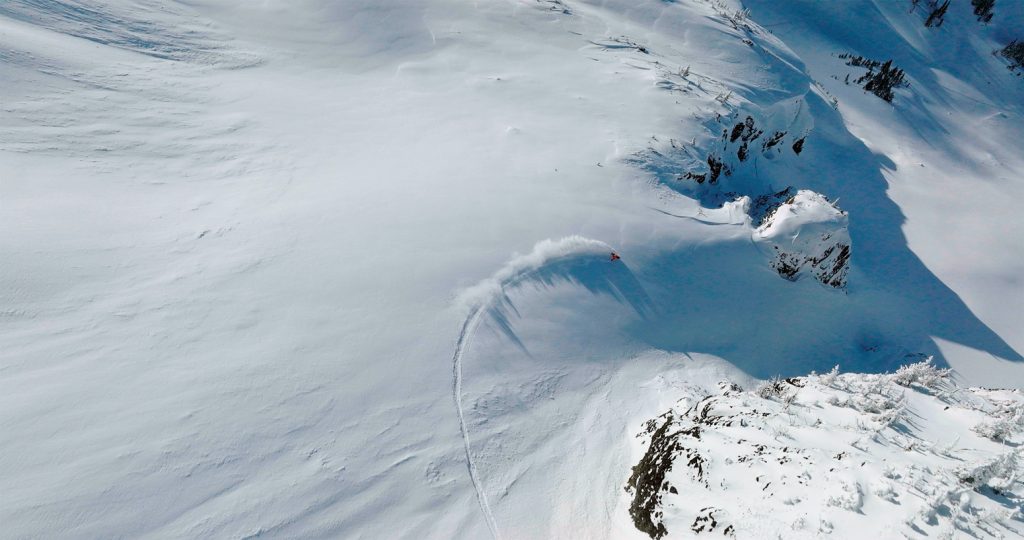
“Mid-February on the first film day of the season, and the best film day of the season. Prime conditions, good stability with Joel Loverin in British Columbia’s Coast Mountains. We were kind of on fire with the conditions allowing us to rail it.”—Joe Lax
Photo: Cameron Sylvester/Reel Water Media
Nevertheless, Joe was hooked. Working nights at a hotel meant riding every single day, which meant progression. By midseason Joe and his gang were in the park, hiking the pipe, and riding with experienced shredders. “I met Scott Macfarland early on, just through working with him,” Joe says. “That was an interesting link to the snowboarding world. He was friends with Greg Todds and Dennis Bannock, guys that were part of Team Core, which was a legendary crew around there. I’d been aware that there was this side of it with movies and magazines and all that, and having some connection to the people who were part of that was cool.
Still, “I wasn’t aspiring to do that myself,” Joe continues, “and even though we were hitting the parks and riding whatever was there, it was already clear that it was maybe too late in the game for me to get good at freeriding. And the resort, staff accom[odations], partying-all-the-time scene seemed like a dead end…but I knew I had to find a way to keep the snowboarding going. Riding powder, riding the bigger mountains, freeriding, all that resonated, and it gave me the basis of something—more the lifestyle than accolades or anything like that—that I could chase.”
By the turn of the century, Joe was in Pemberton. He’d spent a few months in the then-sleepy logging and farming town after his single season at Louise, working maintenance at the golf course and commuting to Whistler to ride the glacier that summer, before being pulled away by the draw of cheap rent and dry powder in the Kootenays. There he cut his teeth in the backcountry, hiking or snowshoeing near Red Mountain, taking an avy course, riding daily. Still, Pemberton held new frontiers. “We were getting into some bigger stuff in the Kootenays, riding some pillows and steeps, but nothing crazy notable,” Joe says. “By then I was idolizing guys like Johan Olofsson, Jeremy Jones, Craig Kelly, Tom Burt, Scott Newsome, and pretty into reading the mags and keeping up with what was going on. Alaska was front and center in Transworld or the Snowboarder Photo Annual. That kind of riding—like the snowboarding itself, not necessarily going to Alaska—was starting to feel like something I could do. It felt like the Kootenays were a bit limiting in terms of exploring that bigger alpine terrain. The Pemberton backcountry already had some buzz—nothing like today, but even then it was a known spot—and I was starting to look up at peaks like Mount Currie while I was working there in the summer and thinking about whether I could ride them. Then my second season at Red was a bust snow-wise, so I moved back midseason and that sealed the deal.”
“THE REAL CRUX MISSIONS WERE THE ONES WHERE WE HAD TO DROP INTO VALLEYS OR DRAINAGES WE DIDN’T KNOW—THERE WAS ALWAYS THE LOOMING QUESTION OF WHETHER WE’D BE ABLE TO GET BACK OUT.”
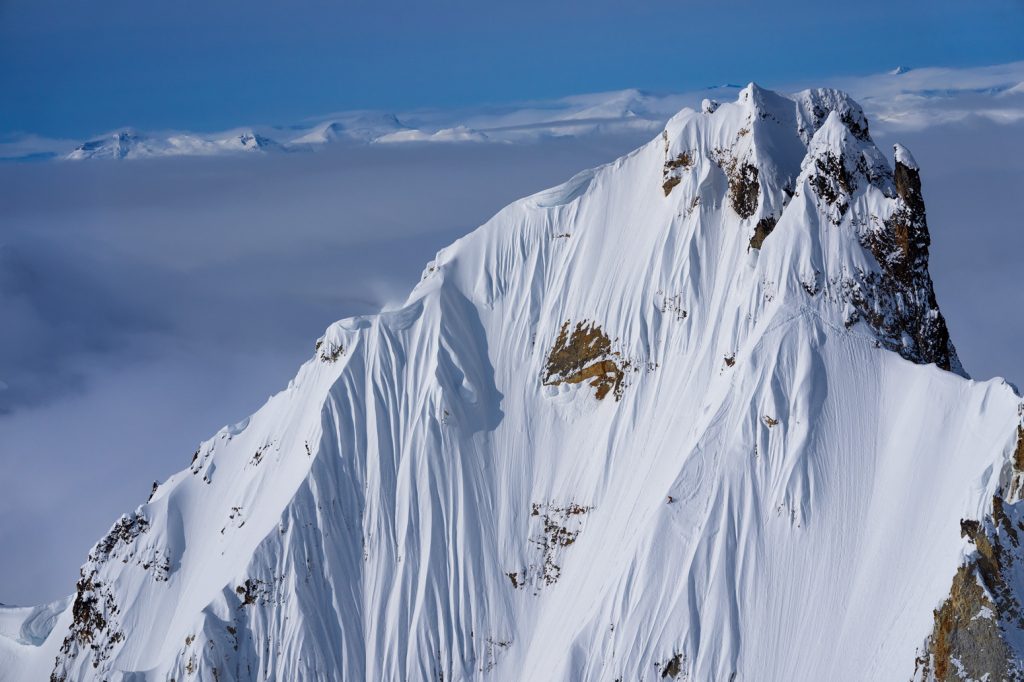
“Mt. Meager, BC, for Arc’Teryx’s film, Shaped by Wild. The very last day of the season, 2022. We’d been trying to get to Meager for a while and we found our moment. With weather closing in, we squeaked this one in just before the clouds swallowed us all.”—Joe Lax
Photo: Angela Percival
That year, 1999-2000, Joe rode the central couloir on Currie. Just four years after he’d first strapped in, he camped on the Ipsoot Glacier and bootpacked big alpine lines. He hiked out to Fissile Peak from Whistler and Decker from Blackcomb and explored the Duffey Lake Road on snowshoes. Under the mentorship of a rider named Kevin Smith, he started taking heli-drops, filling seats with big mountain skiers such as Chris Mansbridge and Jon Johnston (who Joe still rides with today). “Kevin brought me into the scene a bit, he was someone I looked up to and learned a lot from,” Joe says. “At that point there was no turning back. No thoughts of going home, no pressure, just focused on snowboarding every day. Every now and then I wondered what I was gonna do with my life, employment-wise—but I never worried about it, you know?”
At 20 years old, Joe was in the thick of his formative years. Snowboarding, of course, was his primary influence, but wasn’t the only piece determining the trajectory of the young man’s life. The independent streak fostered during his childhood remained, as did his willingness to question the norm. He took up veganism, inspired by books like Diet for a New America. He cut corporations like McDonald’s and Walmart out of his rotation. He recognized what worked for him and what didn’t and was happy to forgo the latter. “With veganism, I just knew it was what I had to do,” he says. “If I don’t need to use animals to survive, this is how I need to live. It led to a lot of conversations, even confrontations back then, but I never felt like I needed to change anybody’s mind. It was more just something that worked for me.”
Joe’s progressive mindset made him stick out in Pemberton, which he describes as being “pretty redneck back then.” But he could speak the language—the village was about the same size as Lumsden and the locals weren’t so different from the folks back home. In a strange way, he fit in more naturally in a place starving for youth culture than he did in Whistler just 20 miles south. “I was a little overwhelmed by Whistler. I felt a bit out of step with the scene. There was kind of a ‘cool guy’ feel to the whole thing, and I didn’t want to push into that for whatever reason,” Joe says. The early 2000s in Whistler was when a sea-change moment in snowboarding took place, with people such as Devun Walsh and Gaetan Chanut setting a backcountry freestyle tone that would capture the Sea to Sky’s attention for the next decade. Joe was off the radar. What he got into was a different world, one he was happy to explore on the down low.
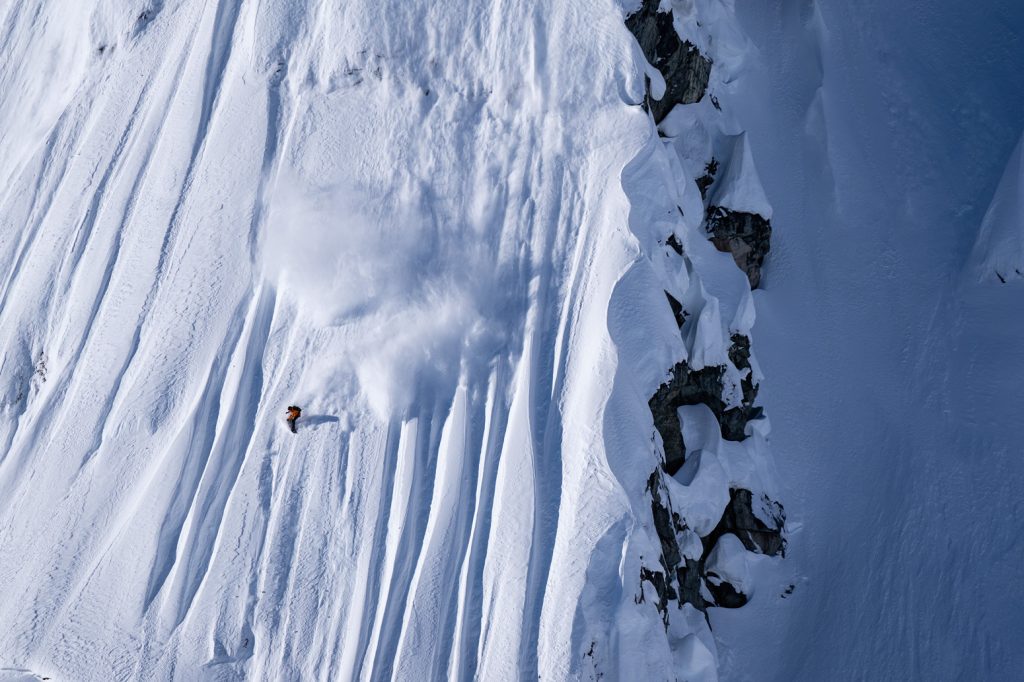
“A rare opportunity to hop in a helicopter with Delaney Zayac for Shaped by Wild. Cold April morning classics in the Coast Mountains.”
—Joe Lax
Photo: Angela Percival
The years that followed are the stuff of legend for those who live for Coast Mountain steeps. Joe got a sled and put in the work opening new zones. “My first sled was a 2000 Summit 136-inch track,” Joe says. “It took a long time to figure it out on those sleds. Lots of getting stuck. But we weren’t afraid to bootpack or snowshoe off the sleds. That happened pretty quickly with peaks like Sun God.”
Initially, Joe and his crew explored established areas known for heli-assisted descents. But it wasn’t long before Joe was applying his growing suite of mountain skills to push into new territory, and picking up a crew of like-minded shredders as he went. “I met friends like Delaney Zayac, Mie Yamashita, Dave Basterrechea and Ian Millar, and we started following the sledders’ tracks and finding these insane zones,” Joe remembers. “All those rednecks and loggers and farmers I spoke of, they were sledding in the mountains, but more or less just driving past these peaks that to us meant more insane terrain, places like the Miller or spots up the Hurley. At first it felt like luck, but eventually we saw what the sledders were doing to get into these places and learned what was possible. As we gained the confidence to do it on our own, we applied their techniques to every other zone that was doable on a sled.” Joe downplays what he means by “techniques,” saying only that some of those missions required shoveling. I remind him of a story I once heard about a late night and a winch. Joe laughs before he starts, “The real crux missions were the ones where we had to drop into valleys or drainages we didn’t know—there was always the looming question of whether we’d be able to get back out. Dave [Basterrechea] and I were on a pow hunt on a low-tide season—treeline was getting beaten down by rain and only the highest peaks were seeing snow, but we were on a mission that required a steep drop-in through trees. We rode down over bare patches and fallen logs before reaching the valley. We spent the day sledding across swamp grass and crossing creeks before reaching the toe of the glacier and realizing there was no boarding to be had. We turned back the way we came and, as we approached the steep exit, we knew we had a problem. After hours of attempts, crashes and road-building, in the dark and close to midnight, we decided to swallow our pride and hiked out, ditching the sleds. The next day we hitched a ride back up armed with ropes and a come-along winch. Even in daylight it seemed impossible to ride the sleds out, as the trail was ice, dirt and fallen logs. We rigged up the sleds and inched them up the hill to where we could ride them out. The funny thing is, I don’t think that gong show deterred us from doing the same thing again—it almost fueled the confidence that we could overcome these obstacles.”
“IT’S DEFINITELY AN EVOLUTION, YOU KNOW, AS IT SHOULD BE.”
“It was a particularly desperate season with very little snow. In late April, we had one last snowfall that coated the high country. Brad Slack and I camped out, woke up at 4 a.m., and made our way up there for sunrise around 6. I had to navigate a bit of variable snow and rock, but riding pink light is always a good time.”—Joe Lax
Photo: Bradley Slack
As Joe and his crew brought their DIY approach to mountains like Rhododendron Mountain, Mt. Meager, Plinth Peak and Mt. Samson, other new adventures kicked off on the valley floor. Joe and Ulla got together in 2003, the same year Joe sniffed out an employment opportunity at the BC Wildfire Service’s Pemberton Fire Base. Firefighting meant decent money for seasonal work, a perfect way to continue snowboarding. “I liked working hard, and that type of manual labor came naturally, growing up on a farm,” Joe says. “At the time it was mostly Indigenous guys on the crew; there were only six or seven white guys, so I learned a lot there, in a good way—about how tight that community was, about this other culture in the valley. They treated us very well and were happy to have us on the crew.”
Despite the challenges of staying vegan in early-2000s fire camps, Joe had found his place. “The risk management, the timing element, a lot of it felt like snowboarding,” he says. “The fact that you’re among Mother Nature and on the whim of what she decides, trying to make decisions that align with that…and the knowledge of the backyard made me a better firefighter.”
Over the next decade, Joe honed his summer and winter crafts, never asking for more. He and Ulla bought a house. A few years later, they started a family. The rhythm he’d struck was working. He was still pushing his riding—the lifestyle he’d envisioned at 17 in Lake Louise had become a reality. In 2010, he had his first action photos published in Snowboard Canada, and the local rep for Völkl Snowboards asked him to ride their boards. He became the supervisor of his unit crew, the leader of his 20-person summer team. But nothing really changed, and nothing really needed to.
When I met Joe in 2015, about to start at the Pemberton Fire Base myself and harboring my own big mountain aspirations, I didn’t know who he was. By then he was an officer, no longer working on the crews, and though he was keen to talk about snowboarding, he never let on just how deep that line went. Not long after, I had the quintessential young Pemberton freerider experience of looking at his Instagram (@whiskytahoe) for the first time, and from then on I had a new favorite rider. Joe had a following by then. He had had added Arc’Teryx and Dissent Labs to his list of sponsors, and his image had graced the pages of snowboard media several more times (including this Journal). He got on Jones Snowboards in 2017, becoming one of their prominently featured riders, landing catalogue spreads and linking with riders such as Ryland Bell for Jones shoots in Pemberton. The same year he was asked to join the incident management team.
“Joe during a three-day spring camping trip deep in the Whistler, BC, backcountry. Using spade shovels early in the morning to cut sidehill trails through frozen avalanche debris, we arrived at this spine-covered pile of rubble held together by volcanic ash and sand. Usually guarded by a huge cornice, we took our opportunity to put some first descents down this beautiful line.” Photo: Joel Loverin
As an operations section chief, Joe was now responsible for coordinating all the resources, from crews to heavy equipment to aircraft, responding to the most complex wildfires in British Columbia. “2017 was stressful,” Joe says. “Coming in as a trainee to a mega fire season, one where so much of the Chilcotin burned and it felt like we were fighting wildfires in the urban interface instead of in the forest…I don’t think I knew what that was going to be. There was a lot more responsibility, and more challenges—a lot more stress than I had hoped. But I learned a lot and I went back the next year, started to find my rhythm. My leadership style is a lot different than a lot of the people in that role, but eventually I built a confidence, like, ‘OK, I know what I’m doing, sort of.’ I mean you never really know what you’re doing and you’ve got to stay humble. But you’re forced to deal, you’re forced to make decisions and there could be consequences if you make the wrong one—maybe that’s your parallel with snowboarding.”
I look to Joe with reverence. The examples he’s set, both in snowboarding and wildfire, have shaped my life to a massive extent, and to me, his lack of pretense through it all shows character matched only by his continued dedication to his uncompromising ideals. The dude’s in his 40s and filming snowboard parts, the last few years with a heli budget. This fall, he and his riding partner Joel Loverin will be the subjects of a major project by Reel Water Productions. And he’s got a beautiful family that he rides with on the regular. I ask him if he feels a sense of continuity now with his days of hiking grassy slopes at Lake Louise.
“It’s definitely an evolution, you know, as it should be,” he says. “I think that I’d be happy with my life choices, looking back. I guess everybody’s gotta sell out at some point, but I’d say that I could somewhat hang with my 19-year-old self. I’d like to think that I’ve stayed true, that the desire to snowboard is still there for the right reasons. There’s a little more balance now with the family piece. There are days I could be out there when I choose to be with them, but even that isn’t a compromise, it’s just what I want to be doing.”
